 sgrais
sgraisMovement
What
occurs within an image to give the illusion of movement of people or objects,
when, obviously, neither people nor frames actually move?
1. Suspended Movement/ Stilled Motion
Single images that freeze the action of movement by capturing a moment of it in
a 'split-second' of time
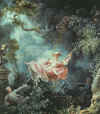 Jean-Honore Fragonard The
Swing 1767
Jean-Honore Fragonard The
Swing 1767
 Jacques Henri Lartigue Grand Prix of the
Automobile Club of France 1911
Jacques Henri Lartigue Grand Prix of the
Automobile Club of France 1911
 Barbara Morgan, Martha Graham 1940
Barbara Morgan, Martha Graham 1940
Slow Shutter Speed
This photograph of a running stream was created using a slow shutter speed because of the cloudy effect of the moving water.
 John Sexton Merced
River and Forest, Yosemite Valley, California 1983
John Sexton Merced
River and Forest, Yosemite Valley, California 1983
![]() Paul Caponigro, Conty Wicklow, Ireland
Paul Caponigro, Conty Wicklow, Ireland
 John Goodman Two Wrestlers,
Havana, Cuba, 2000
John Goodman Two Wrestlers,
Havana, Cuba, 2000
Decisive Movement
Photographer Henri Cartier-Bresson used his understanding of impending change to
formulate a theory
of photography he called "decisive moment." A pioneer in the use of the 35-mm
camera, he caught
images at the moment of greatest impact, creating photographs that are charged
with possibilities.
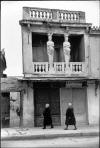
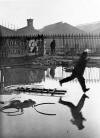
2. Summarized Movement
Single images that summarize a sequence of events in one frame
as in the concept of a journey in John Ogilby's 17th century maps;
the narrative of the Norman Conquest in the Bayeux Tapestry
3. Simulated Movement
Single Images that evoke movement by showing the progress of the action
In film
and animation, a series of still pictures are shown in rapid succession in order
to simulate movement.
On the
static page there is no way to simulate actual movement.
The most that can be done is to use techniques that convey a sense of movement, and rely upon the reader's imagination to perceive those techniques as actual movement.
The most
common technique is the use of lines to indicate movement.
Thin
lines drawn behind an object or character indicate the direction and speed of
movement.
Blurred edges of the forms in a picture can simulate the act of motion.
It is generally the case that the more blurred the image the faster the speed depicted.
Another technique for evoking movement is to show a single figure in a superimposed sequence of movements. These are often often represented in the two extreme positions, and the intermediaries, of a particular movement.
Subjects can be photographed in selected positions across their path of movement, and their resultant multiple exposures on a single print can convey movement.
Étienne-Jules Marey
![]()
Widely considered to be a pioneer of both photography and of cinema.
Marey, a physiologist, spent his lifetime studying the dynamics of movement in its multiple forms. Both animal and human motions fascinated him. To study and measure subtle phenomena that were often imperceptible to the human eye, he used “chronophotography,” a photographic technique that was a precursor to the “moving pictures” of today’s cinema.
Chronophotography was to record several phases of movement in one surface.
His work had a profound influence on modern art expressions such as in the work of Ballà, the Italian Futurist concerned with movement,
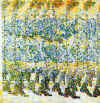
 Giacomo Balla
Girl
Running on a Balcony 1912, Dynamism of a Dog on a Leash 1912
Giacomo Balla
Girl
Running on a Balcony 1912, Dynamism of a Dog on a Leash 1912
In their Manifesto of 1910 the Futurist painters asserted that:
The gesture which we would reproduce on canvas shall no longer
be a fixed moment in universal dynamism. It shall simply be the dynamic
sensation itself. Indeed, all things move, all things run, all things are
rapidly changing. A profile is never motionless before our eyes, but it
constantly appears and disappears. On account of the persistency of an image
upon the retina, moving objects constantly multiply themselves; their form
changes like rapid vibrations, in their mad career.
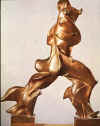
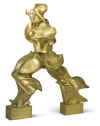
![]() Umberto Boccioni Unique forms of Continuity in Space
1913
Umberto Boccioni Unique forms of Continuity in Space
1913
His work is also credited with serving as the point of departure for Marcel Duchamp’s famous painting “The Nude Descending the Staircase.”
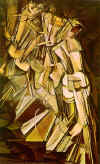 Marcel Duchamp Nude Descending a Staircase
No. 2 1911
Marcel Duchamp Nude Descending a Staircase
No. 2 1911
During the 1860s Marey threw himself into the study of flight, first of insects and then birds. His aim was to understand how a wing interacted with the air to cause the animal to move.
In 1890 he published a substantial volume entitled Le Vol des Oiseaux (“The Flight of Birds”) richly illustrated with photographs, drawings, and diagrams.
He also created stunningly precise sculptures of various flying birds.
He also devised some ingenious apparatus based on his graphical method, such as a corset which allowed a bird to fly around a circular track while recording the movements of its thorax and wings.
Deemed to be one of the first theoreticians of aeronautics. He was attracted by invisible phenomena concerning air currents and the resistance of air in the flight of birds. His last experiments were concerned with the observation and instant photographic recordings of smoke currents. He created a “smoke machine” that was one of the first modern aerodynamic wind tunnels, later adopted by Gustave Eiffel, and still used today.
Marey photographed the diverse forms assumed by wisps of smoke projected through obstacles in his wind tunnels.
Gjon Mili
Working with Harold Eugene Edgerton of MIT, Gjon Mili was a pioneer in the use of stroboscopic instruments to capture a sequence of actions in one photograph. Trained as an engineer and self-taught in photography, Gjon Mili was one of the first to use electronic flash and stroboscopic light to create photographs that had more than scientific interest. Many of his notable images revealed the beautiful intricacy and graceful flow of movement too rapid or complex for the naked eye to discern. In the mid-1940s he was an assistant to the photographer Edward Weston.
http://en.wikipedia.org/wiki/Gjon_Mili
Multiplication
As an object moves, it sequentially occupies multiple spaces. Visual
multiplication helps capture
such movement.

![]()
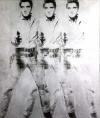
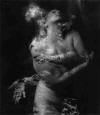

Multiplication creates a different effect in George Tooker's
Government Bureau.
Repeated images of the central male figure combined with endless bureaucratic
faces
creates a scene from a nightmare. No matter where the man goes in the hall of
mirrors,
he always returns to the beginning.
 Government
Bureau, 1956
George Tooker
Government
Bureau, 1956
George Tooker


http://www.metmuseum.org/collections/search-the-collections/484972
4. Active Movement
Tracks of movement suggested in the physical execution of making an image
The act of creating an image is a sequential process (Paul Klee described the act of drawing as 'taking a line for a walk').
The 'Action' Painters captured the energy and broad movements put into carrying out the act of painting itself.
 Jackson Pollock Lavender Mist Number 1
1950
Jackson Pollock Lavender Mist Number 1
1950
A style of abstract painting that uses techniques such as the dribbling or splashing of paint to achieve a spontaneous effect. In Action Painting the canvas is the arena in which the artist acts. The action of painting becomes the focus, the canvas becomes the record of the event.
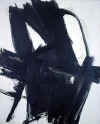
 Franz Kline Merce C
1961, Siskind 1958
Franz Kline Merce C
1961, Siskind 1958
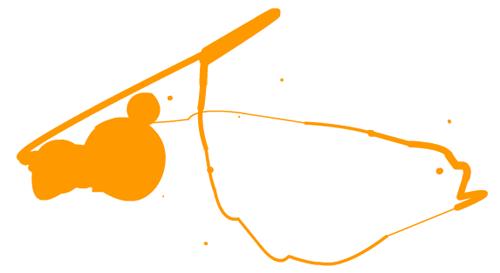
http://stamen.com/projects/splatter
5. Optical Movement
Single Images that evoke the optical illusion of actual movement
6. Sequential Movement
Multiple images that summarize a sequence of events in a series of frames
Movement can also be suggested in step-and-repeat instructional illustrations.
The comic strip is usually a story consisting of pictures that are juxtaposed in sequence. The action of the story unfolds in a sequence of events with successive pictures that are usually closely linked in time.
The time element in between consecutive pictures, however, can vary - there may be a split second between connecting images or minutes, hours, days and even years.
The breaks are as much an important consideration as the pictures themselves. Comic strips anticipated the story-boards created for films where the main features of the plot are rendered first; then the gaps are filled in for the final production.
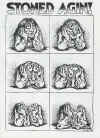 Robert Crumb Stoned Agin!
1971
Robert Crumb Stoned Agin!
1971

![]()
![]() Robert Crumb A Short History
of America 1979
Robert Crumb A Short History
of America 1979
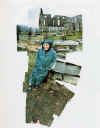 David Hockney My Mother,
Bolton Abbey, Yorkshire 1982
David Hockney My Mother,
Bolton Abbey, Yorkshire 1982